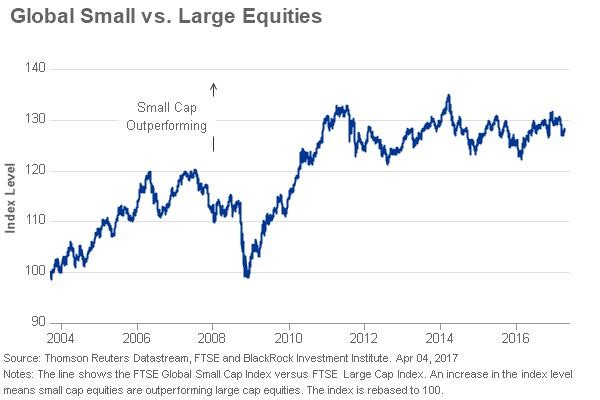U.S. stocks are off to another stellar year. Look below the surface, however, and the rally has had a somewhat unusual flavor. Some of the better performing stocks are in the more defensive industries, such as utilities and health care, while small caps—a strong performer in late 2016—are trailing. Year-to-date the S&P 500 has gained over 5%, versus barely 1% for the Russell 2000 Index. Nor is this just a U.S. phenomenon. Globally, the small cap rally has stalled (see the chart below).
Written by Russ Koesterich (BlackRockBlog.com)
What accounts for the reversal in fortune and will it continue?

Late last year I suggested that the small cap surge might struggle in 2017. Before focusing on why this should be the case, let me dispense with one suspect: the reversal in the U.S. dollar. In fact, this is a symptom rather than the cause of the recent underperformance.
As I described late last year, since 2000 the relative performance of small caps has been largely independent of what happens in currency markets. While U.S. small caps have a slight tendency to outperform when the dollar is strengthening, the relationship is fairly weak and not statistically significant.
If a faltering dollar rally is not to blame, what is? I see two culprits.
1. Risk appetite turned
The turn in the dollar, while not directly the cause of small cap underperformance, is indicative of a broader pattern: The “reflation trade” that began in mid-2016 has been struggling of late. One manifestation of this has been the recent pullback in credit, specifically high yield. This is important. Since 2000, monthly changes in high yield spreads have explained roughly 10-15% of small cap’s relative performance. If appetite for high yield bonds continues to moderate, this is indicative of a dampening in risk appetite, a scenario that does not favor small cap names.
2. Valuations are still stretched
Neither large nor small cap U.S. stocks are cheap, but small caps look particularly pricey. The Russell 2000 was already expensive last December; at nearly 48x trailing earnings it is even more so today. Instead, many investors are starting to look for better bargains overseas. For those willing to take the incremental risk, at 15x trailing earnings emerging market equities seem the more interesting play, a fact reflected in their outperformance year-to-date.









Leave A Comment